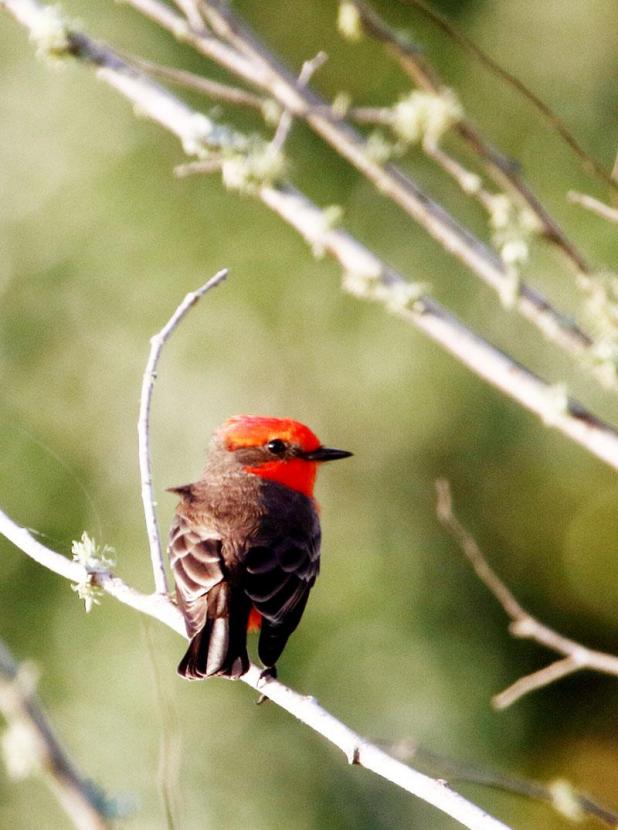
This Vermilion Flycatcher has spent the past couple of weeks at Cypremort Point State Park. (Submitted Photo/John K. Flores)
Winter months offer opportunities to see rare species
A couple weeks back, Bayou Vista resident and President of the Terrebonne Bird Club, Paul Schaub, got on Facebook to let bird enthusiasts know about several Vermilion Flycatchers that he spotted at Cypremort Point State Park.
In George H. Lowery, Junior’s book, “Louisiana Birds – 3rd Edition”, it states, “The regular presence in winter of Vermilion Flycatchers in Louisiana and elsewhere on the northern Gulf Coast is not easy to explain, since the species is a bird of southwestern United States and Mexico. To reach Louisiana in the fall, these little flycatchers must, as a minimum, move more than a thousand miles eastward (if our birds come from Nevada or Utah) or hundreds of miles to the northeast (if they come from the lower Rio Grande Valley). In either case, they come at a time when migratory birds ordinarily are moving southward.”
Though Vermilion Flycatchers do winter over in Louisiana, you wouldn’t consider their presence common. Rare is perhaps a better reflection of their presence. Therefore, upon Schaub’s announcement, I had to go see these extraordinary visitors with my own eyes and maybe get a few quality pictures of one if the opportunity lent itself to it.
I wasn’t disappointed, either. The birds were pretty much hanging out in plain sight. They were perched in the oak trees near each of the restrooms or in the palm trees along the road, where they had full view of the well-groomed field in between. Additionally, the mowed grass and shallow ditch along the road provided an abundance of insects for them to feed on.
However, Vermilion Flycatchers aren’t the only birds that call Louisiana home in the winter. About the same week Schaub discovered the flycatchers at the state park, a woodcock found my wife’s flower garden in our backyard and stayed with us for a little over a week.
Prior to this recent visit, I’ve only been close to woodcock when hunting them and on one other occasion while banding them with the Louisiana Department of Wildlife and Fisheries. Woodcock are a popular gamebird whose numbers have declined the past few decades as northern forests have matured and urban sprawl has gobbled up habitat.
Woodcock like thick stands of early successional growth forest with moist soil. I’m not sure what the bird found to its liking in Christine’s flower garden, but needless to say, we enjoyed its visit.
The point to all of this is fall and winter birding in Louisiana can be phenomenal. It also can be serendipitous.
Marybeth Lima is a professor of biology and agricultural engineering at Louisiana State University. She is also author of, “Adventures of a Louisiana Birder: One Year, Two Wings, Three Hundred Species.”
Lima says she loves birding in Louisiana during the winter months because of the great diversity and impressive numbers of birds that one can see.
“This is the time of year when I have to brush up on my chip notes, which seems to be most of what I hear while birding ‘bundled up,’ Lima said. “Rice country is one of my favorite winter birding destinations because of the massive flocks of snow geese and greater white-fronted geese in the fields. I enjoy being able to hear thousands of geese from miles away, and to me, the collective V-formations of geese in the sky look like a painting.
“With pops of color courtesy of Vermilion Flycatcher, Yellow-Bellied Sapsucker and Cedar Waxwing, the challenges of identifying ducks in flight and the distinct possibility of finding rarities, I’m ‘all in,’ on winter birding,” Lima continued.
Some other species of birds that make Louisiana their winter home are Fox Sparrows, Song Sparrows and Lincoln’s Sparrows. Eastern Phobes, Golden-crowned Kinglets, Ruby-crowned Kinglets and Yellow-rumped Warblers also winter here in the state.
Where the songbirds go, the raptors follow. Red-shoulder Hawks, Northern Harriers, Sharp-Shinned Hawks, Merlins and American Kestrels follow the smaller birds south to the wintering grounds.
Depending on where you start your birding expedition, between shorebirds, songbirds, wading birds and waterfowl, good birders often can identify 100 different species during a winter outing. Because of the availability of public land, southwest Louisiana is hard to beat. But, more locally, Brownell Memorial Park & Carillion Tower in Morgan City, Cotton Road in Patterson and Bayou Teche National Wildlife Refuge are all great birding destinations in the fall and winter months.
For those interested in a signed copy of Lima’s book, “Adventures of a Louisiana Birder,” you can email her at marybeth.lima@gmail.com.
EDITOR’S NOTE: Flores is The Daily Review’s Outdoor Writer.
